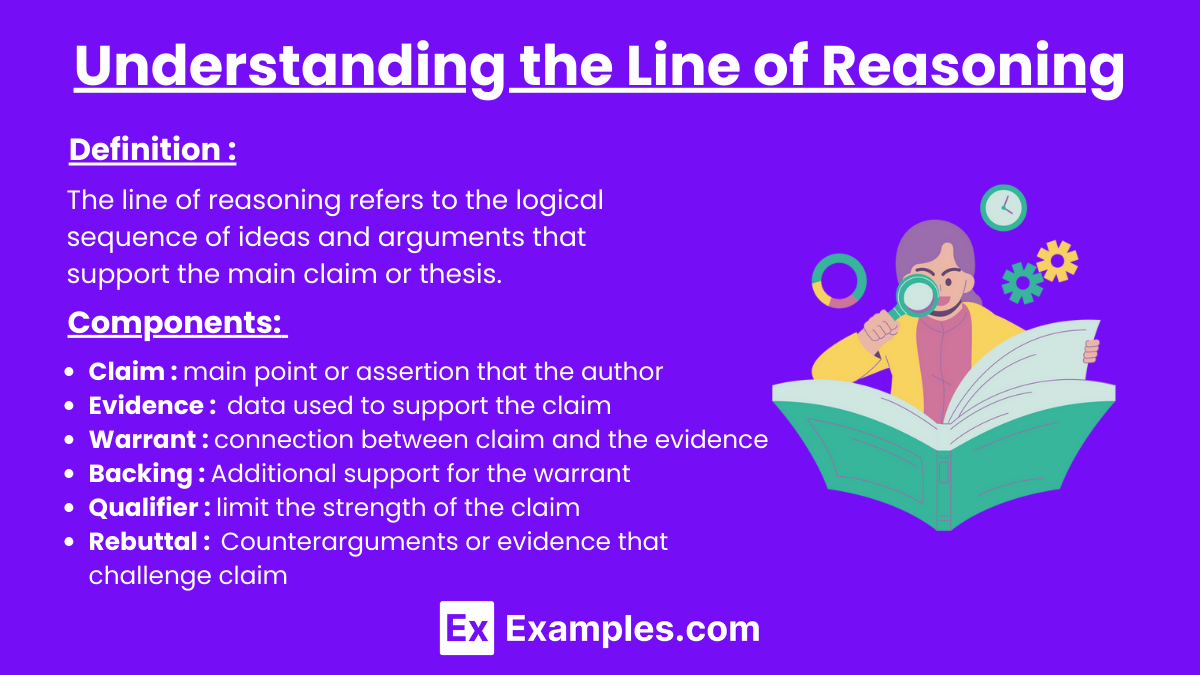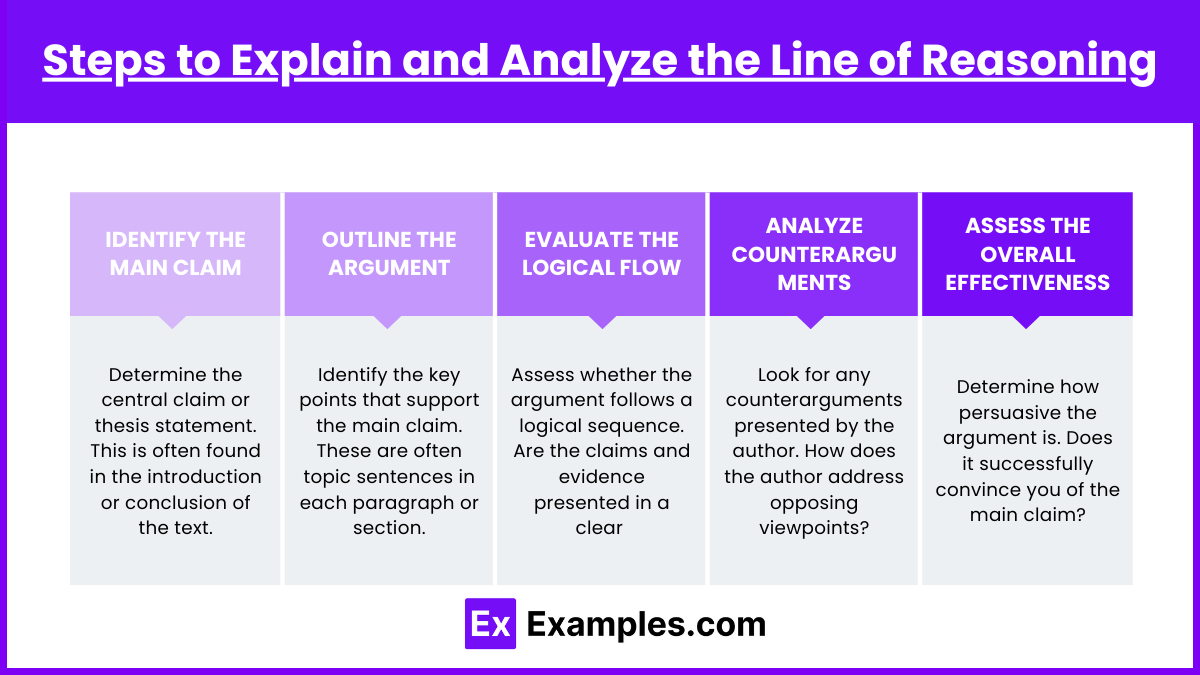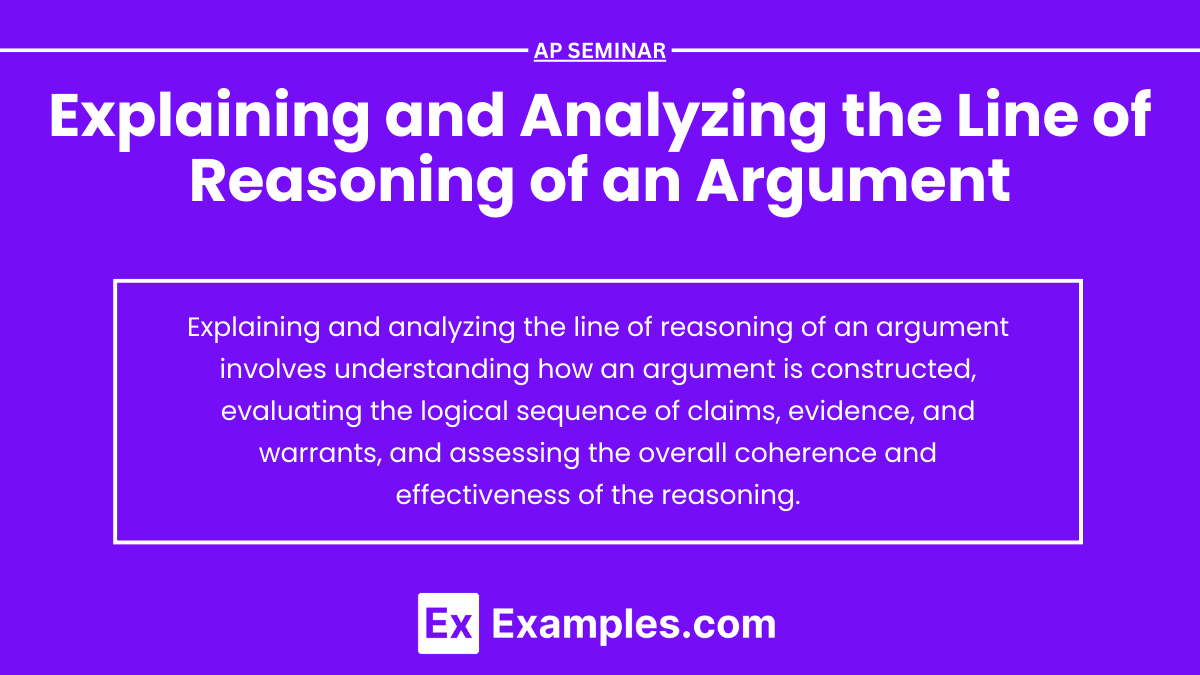Explaining and analyzing the line of reasoning of an argument involves understanding how an argument is constructed, evaluating the logical sequence of claims, evidence, and warrants, and assessing the overall coherence and effectiveness of the reasoning. This skill is crucial for the AP Seminar exam, as it enables students to critically engage with texts, identify strengths and weaknesses in arguments, and construct well-supported responses. Mastery of this process enhances analytical thinking and improves the ability to communicate complex ideas clearly and persuasively.
Learning Objectives
Explaining and Analyzing the Line of Reasoning of an Argument” in the AP Seminar exam include mastering the identification and breakdown of an argument’s structure, including its main claim, supporting claims, evidence, and warrants. Students should learn to assess the logical flow, coherence, and consistency of arguments, identify and evaluate counterarguments, and recognize logical fallacies and biases. Additionally, students should develop the ability to critically evaluate the quality and relevance of evidence used to support claims. These skills are crucial for constructing well-supported arguments and effectively analyzing complex texts, ultimately leading to success in the AP Seminar exam.
Understanding the Line of Reasoning

The line of reasoning refers to the logical sequence of ideas and arguments that support the main claim or thesis. It involves the connections between claims, evidence, and warrants that the author uses to build their argument.
Components of an Argument
- Claim: The main point or assertion that the author is trying to prove.
- Evidence: The data, facts, or examples used to support the claim.
- Warrant: The logical connection between the claim and the evidence.
- Backing: Additional support for the warrant, often in the form of further evidence or reasoning.
- Qualifier: Statements that limit the strength of the claim or specify the conditions under which it is true.
- Rebuttal: Counterarguments or evidence that challenge the claim, along with the author’s response to these counterarguments.
Steps to Explain and Analyze the Line of Reasoning

1. Identify the Main Claim
- Locate the Thesis: Determine the central claim or thesis statement. This is often found in the introduction or conclusion of the text.
- Understand the Scope: Recognize the extent and limits of the claim. What exactly is the author asserting?
2. Outline the Argument
- List Supporting Claims: Identify the key points that support the main claim. These are often topic sentences in each paragraph or section.
- Trace the Evidence: Note the evidence provided for each supporting claim. What types of evidence are used (e.g., statistics, expert testimony, anecdotes)?
- Examine the Warrants: Understand how the author connects the evidence to the claims. Are these connections logical and well-supported?
3. Evaluate the Logical Flow
- Coherence: Assess whether the argument follows a logical sequence. Are the claims and evidence presented in a clear and organized manner?
- Consistency: Check for consistency in the argument. Are there any contradictions or gaps in the reasoning?
- Strength of Evidence: Evaluate the quality and relevance of the evidence. Is it credible, sufficient, and directly related to the claim?
4. Analyze Counterarguments
- Identify Rebuttals: Look for any counterarguments presented by the author. How does the author address opposing viewpoints?
- Evaluate Responses: Assess the effectiveness of the author’s responses to counterarguments. Are they convincing and well-supported?
5. Assess the Overall Effectiveness
- Persuasiveness: Determine how persuasive the argument is. Does it successfully convince you of the main claim?
- Clarity and Precision: Consider the clarity and precision of the argument. Are the claims, evidence, and reasoning clearly articulated?
- Logical Soundness: Evaluate the overall logical soundness of the argument. Are there any logical fallacies or weaknesses in the reasoning?
Techniques for Effective Analysis
To effectively analyze the line of reasoning in an argument, you need a structured approach that helps you break down and evaluate each component of the argument.
Toulmin Model of Argumentation
The Toulmin Model provides a practical framework for dissecting arguments into their core components. It helps in understanding the structure and evaluating the strength of an argument.
- Claim: The main assertion or conclusion that the argument seeks to prove.
- Example: “Climate change is a significant threat to global ecosystems.”
- Data (Evidence): The facts, statistics, or other forms of evidence that support the claim.
- Example: “Global temperatures have risen by 1.2 degrees Celsius since the pre-industrial era.”
- Warrant: The logical connection between the claim and the evidence. It explains why the data supports the claim.
- Example: “Rising temperatures lead to melting ice caps, which disrupts marine life and coastal ecosystems.”
- Backing: Additional support for the warrant, providing further justification and reinforcement.
- Example: “Studies from NASA and NOAA provide robust data on temperature changes and their impacts.”
- Qualifier: Statements that limit the strength of the claim, acknowledging that it may not be absolute.
- Example: “While temperature rises are generally harmful, some regions may experience temporary benefits.”
- Rebuttal: Counterarguments or evidence that challenge the claim, along with responses to these challenges.
- Example: “Some argue that climate change is a natural phenomenon, but overwhelming evidence shows human activity is a primary driver.”
Socratic Questioning
Socratic Questioning is a technique that involves asking a series of probing questions to explore the depth and validity of an argument. It encourages critical thinking and deeper understanding.
- Clarification Questions: Aim to understand the argument better.
- Example: “What do you mean by ‘significant threat’? Can you provide a specific example?”
- Assumption Questions: Challenge the assumptions underlying the argument.
- Example: “What assumptions are you making about the causes of climate change? Are these assumptions supported by evidence?”
- Evidence Questions: Evaluate the quality and relevance of the evidence provided.
- Example: “What evidence do you have to support this claim? How reliable is this evidence?”
- Implication Questions: Consider the consequences and implications of the argument.
- Example: “What are the potential impacts if we do not address climate change? How might this affect future generations?”
- Counterargument Questions: Explore alternative viewpoints and their implications.
- Example: “How would you respond to someone who argues that climate change is a natural cycle? What evidence contradicts this view?”
Critical Thinking Framework
A critical thinking framework involves a systematic approach to dissecting and evaluating an argument. It helps in identifying strengths, weaknesses, and potential biases.
- Purpose: What is the purpose of the argument? Understanding the author’s intent helps in evaluating the relevance and focus.
- Example: “The purpose of this argument is to highlight the urgency of addressing climate change.”
- Question: What question is the author trying to answer? Clarifying the research question or problem provides context.
- Example: “The author is addressing the question of whether climate change poses a significant threat to global ecosystems.”
- Information: What information does the author use to support the argument? Assessing the quality and relevance of this information is crucial.
- Example: “The argument is supported by data on rising global temperatures, melting ice caps, and disrupted ecosystems.”
- Concepts: What key concepts and ideas are used in the argument? Understanding these concepts helps in grasping the argument’s depth.
- Example: “Key concepts include global warming, ecosystem disruption, and human impact on climate change.”
- Assumptions: What assumptions underlie the argument? Identifying these assumptions helps in evaluating the argument’s foundation.
- Example: “The argument assumes that human activities significantly contribute to climate change.”
- Inferences: What inferences are drawn from the evidence? Evaluating the logical connections between evidence and conclusions is essential.
- Example: “The inference is that rising temperatures caused by human activities are leading to ecosystem disruptions.”
- Point of View: What is the author’s point of view? Recognizing the author’s perspective helps in understanding potential biases.
- Example: “The author’s point of view is that urgent action is needed to mitigate climate change.”
- Implications: What are the implications and consequences of the argument? Considering these implications helps in understanding the argument’s broader impact.
- Example: “The implication is that failure to address climate change could have catastrophic effects on the environment and human societies.”


